Term 1 Chapter 3 | 6th Maths - Ratio | 6th Maths : Term 1 Unit 3 : Ratio and Proportion
Chapter: 6th Maths : Term 1 Unit 3 : Ratio and Proportion
Ratio
Ratio
Think about this Situation
Let us consider a situation of cooking rice for
two persons. The quantity of rice required for two persons is one cup. To cook every
one cup of rice, we need to add two cups of water. Assuming that 8 more guests join
for lunch, will the use of ratio help us in handing this situation?
It is possible to trace the origin
of the word "ratio" to the Ancient Greek Medieval. Writers used the word proprotio
("proportion") to indicate ratio and proportionalities ("proprotionality") for the equality of ratios.
Early translators rendered this into Latin as
ratio ("reason"; as in the word "rational")
The number of cups of rice and water required are given below.

In all the cases, the number of cups of water (or)
the number of persons is 2 times the number of cups of rice. So, we write
Number of cups of rice : Number of cups of water
(or) the number of persons = 1 : 2 Such comparison is called as a Ratio.
Note
● A ratio is a comparison of two quantities.
● A ratio can be written as a fraction;
ratios are mostly written in the simplest form.
● In the above example, the ratio
of rice to water in terms of the number of cups can be written in three different
ways as 1 : 2 or 1/2 or 1 to 2 .
Try these
1. Write the ratio of red tiles to blue
tiles and yellow tiles to red tiles.

Answer:
Yellow: 2/7
Blue: 3/7
Red: 2/7
2. Write the ratio of blue tiles to that
of red tiles and red tiles to that of total tiles.

Answer:
Blue: 3/8
Red: 5/8
3. Write the ratio of shaded portion
to the unshaded portions in the following shapes.
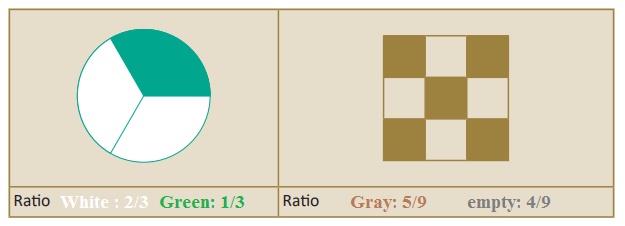
1.
Properties of Ratio
● A ratio has no unit. It is a number. For example,
the ratio of 8 km to 4 km is written as 8 : 4 = 2 : 1 and not 2
km : 1 km.
● The two quantities of a ratio should be of the same unit. The ratio of 4 km to 400 m is expressed as
(4 × 1000) : 400 = 4000 : 400 = 10 : 1
● Each number of the ratio is called a term.
● Order of the terms in a ratio cannot be reversed.
A few examples are given below.

(a) Ratio of the number of small fish
to the number of big fish is 5 : 1
(b) Ratio of number of teeth in front
gear to number of teeth in back gear is 25 : 50
For example, the ratio of the number of big fish
to the number of small fish is 1 : 5. The same information cannot be written as 5 : 1 and so, 1 : 5 and 5 : 1 are
not the same.
Similarly, if in a class, there are 12 boys and
12 girls, then the ratio of number of boys to the number of girls is expressed as
12 : 12 which is the same as 1 : 1.
Try this
If the given quantity is in the same
unit, put ✓ otherwise put X in the table below.

2.
Ratios in simplest form
Think about these situations

1. The larger rope is
4 m long and the smaller rope is 2 m long. This is expressed in the form of
ratio as 4 : 2 and the simplest form of ratio of the larger rope to the smaller
rope is 2 : 1 (See Fig. 3.2 (a))
2. The cost of a car
is ₹ 5,00,000
and the cost of a motorbike is ₹ 50,000. This is expressed as 500000 : 50000 = 50
: 5 and the simplest form of ratio of the car to the motorbike is 10 : 1 (See Fig.
3.2 (b))
3.
Simplifying ratios of same unit
Example 3.1
Simplify the ratio 20 : 5.
Solution
Step 1: Write the ratio in fraction form as
20/5.
Step 2: Divide each quantity by 5. That is, 
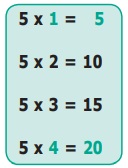
This is the ratio in the simplest form.
Example 3.2
Find the ratio of 500 g to 250 g.
Solution
500 g to 250 g = 500 : 250
500 /250 = 500÷250 / 250÷250 = 2/1 = 2 : 1
This is the ratio in the simplest form.
Example 3.3
Madhavi and Anbu bought two tables for ₹ 750
and ₹ 900
respectively. What is the ratio of the prices of tables bought by Anbu and Madhavi?
Solution
The ratio of the price, of tables bought by Anbu
and Madhavi
= 900:750 = 900 / 750
(900 ÷ 150) / (750 ÷150) = 6/5 = 6:5
This is the ratio in the simplest form.
4.
Simplifying ratios of different units
Example 3.4
What is the ratio of 40 minutes to 1 hour?
Solution
1 hour = 60 minutes
20 × 1 = 20
20 × 2 = 40
20 × 3 = 60
Step 1: Express the quantity in the same unit.
(Hint : 1 Hour = 60 minutes)
Step 2: Now, the ratio of 40 minutes to 60 minutes
is 40:60
40/60 = 40÷20 / 60÷20 = 2/3 = 2:3
This is the ratio in the simplest form.
Try these
Write the ratios in the simplest form
and fill in the table.
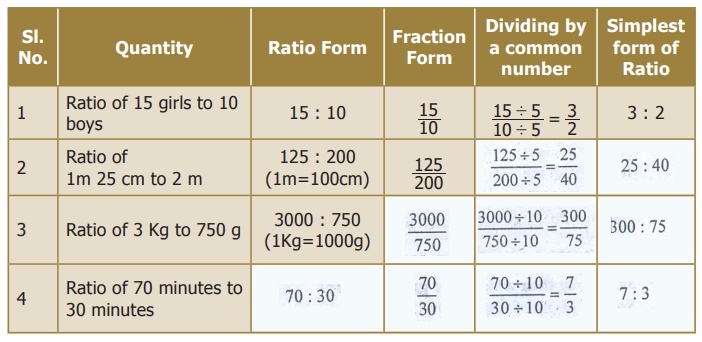
5.
Equivalent Ratios
We can get equivalent
ratios by multiplying or dividing the numerator and denominator by a
common number. This is clear from the following example. Let us find the ratio
between breadth and length of the following rectangles given in the Figure 3.3

● Ratio of breadth to length of rectangle A is 1
: 2 (already in simplest form)
● Ratio of breadth to length of rectangle B is 2
: 4 (simplest form is 1 : 2)
● Ratio of breadth to length of rectangle C is 4
: 8 (simplest form is 1 : 2)
● Thus, the ratios of breadth and length of
rectangles A, B and C
are said to be equivalent ratios.
● That is, the ratios 1 : 2 = 2 : 4 = 4 : 8
are equivalent. (See Fig. 3.3)
Try these
1. For the given ratios, find two
equivalent ratios and complete the table.

2. Write three equivalent ratios
and fill in the boxes.

3. For the given ratios, find their
simplest form and complete the table.

6.
Comparison of Ratios
Consider the following situations.
Situation 1
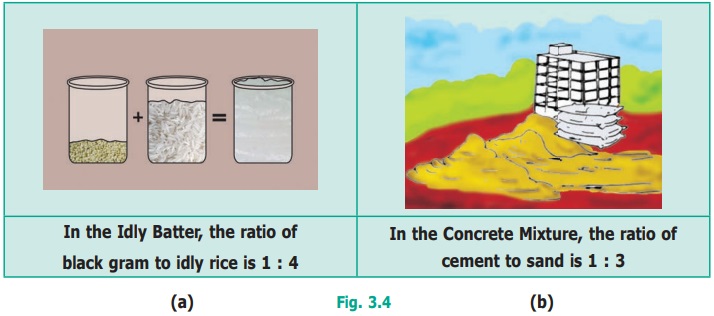
Can you find which ratio is greater in Fig.
3.4?
Express ratios as a fraction and then find the
equivalent fractions, until the denominators are the same, and compare the
fractions with common denominators. This is done as follows :
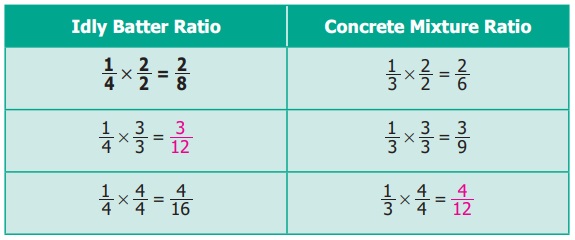
Comparing the equivalent ratios, 4/12 &
3/12, we can conclude that 1 : 3 is greater than 1 : 4
Situation 2
Let us consider another situation. For example,
if a thread of 5 m is cut at 3 m, then the length of two pieces are 3 m and 2 m and the ratio of the two pieces is 3 : 2. From this we say that,
a ratio ‘a : b’ is said to have a total of ‘a+b’ parts in it.
Example 3.5
Kumaran has ₹ 600 and wants to divide it between Vimala and
Yazhini in the ratio 2 : 3. Who will get more and how much?
Solution
Divide the whole money into 2 + 3 = 5 equal
parts then, Vimala gets 2 parts out of 5 parts and Yazhini gets 3 parts out of
5 parts.
Amount Vimala gets = ₹ 600 × 2/5 = ₹ 240
Amount Yazhini gets = ₹ 600 × 3/5 = ₹ 360
Vimala received ₹ 240 and Yazhini gets ₹
360, which is ₹ 120 more than that of Vimala.
ICT Corner
RATIO AND PROPORTION
Expected
Result is shown in this picture
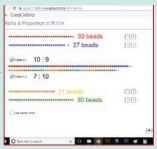
Step
– 1
Open
the Browser and copy and paste the Link given below (or) by typing the URL given
(or) Scan the QR Code.
Step
− 2
GeoGebra
worksheet named “Ratio and Proportion” will open. Two sets of Coloured beads will
appear.
Step-3
Find
the ratio of coloured beads for each pair. You can Increase or decrease the no’s
by pressing “+” and “-“ button appearing on the right side of the page.
Step-4
To
check your answer Press on “Pattern 1” and “Pattern 2” button. Repeat the test by
increasing and decreasing the beads.

Browse in the link
Ratio
and: Proportion − https://www.geogebra.org/m/fcHk4eRW
Related Topics